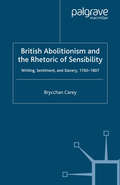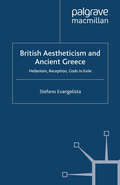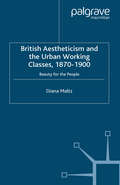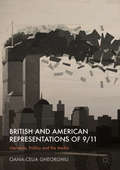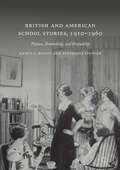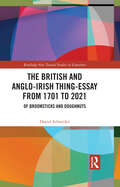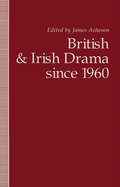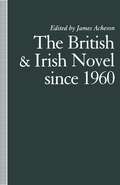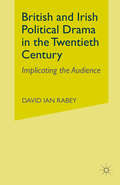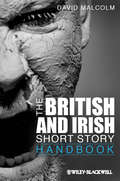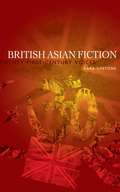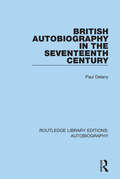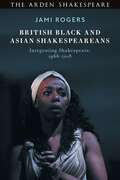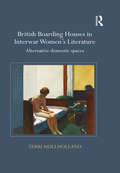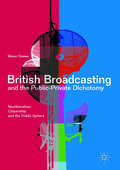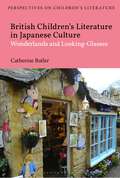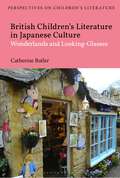- Table View
- List View
British Abolitionism and the Rhetoric of Sensibility: Writing, Sentiment and Slavery, 1760-1807 (Palgrave Studies in the Enlightenment, Romanticism and Cultures of Print)
by B. CareyBritish Abolitionism and the Rhetoric of Sensibility argues that participants in the late eighteenth-century slavery debate developed a distinct sentimental rhetoric, using the language of the heart to powerful effect in the most important political and humanitarian battle of the time. Examining both familiar and unfamiliar texts, including poetry, novels, journalism, and political writing, Carey shows that salve-owners and abolitionists alike made strategic use of the rhetoric of sensibility in the hope of influencing a reading public thoroughly immersed in the 'cult of feeling'.
British Aestheticism and Ancient Greece: Hellenism, Reception, Gods in Exile (Palgrave Studies in Nineteenth-Century Writing and Culture)
by S. EvangelistaThis book is the first comprehensive study of the reception of classical Greece among English aesthetic writers of the nineteenth century. By exploring this history of reception, it aims to give readers a new and fuller understanding of literary aestheticism, its intellectual contexts, and its challenges to mainstream Victorian culture.
British Aestheticism and the Urban Working Classes, 1870-1900: Beauty for the People (Palgrave Studies in Nineteenth-Century Writing and Culture)
by D. MaltzThis cultural study reveals the interdependence between British Aestheticism and late-Victorian social-reform movements. Following their mentor John Ruskin who believed in art's power to civilize the poor, cultural philanthropists promulgated a Religion of Beauty as they advocated practical schemes for tenement reform, university-settlement education, Sunday museum opening, and High Anglican revival. Although subject to novelist's ambivalent, even satirical, representations, missionary aesthetes nevertheless constituted an influential social network, imbuing fin-de-siecle artistic communities with political purpose and political lobbies with aesthetic sensibility.
British and American Representations of 9/11: Literature, Politics and the Media
by Oana-Celia GheorghiuThis book argues that twenty-first-century neorealist fiction is inspired by political and journalistic discourses and, along with them, constitutes one of the many representations of the attacks on September 11 and their outcomes. Adopting a neorealist stance, this book is placed at the intersection of realism and fiction, with often reference to what is perceived as objective writing (media and political texts), not at all so divorced from the practice of literary writings on the event that shook the world on September 11, 2001.
British and American Representations of 9/11: Literature, Politics and the Media
by Oana-Celia GheorghiuThis book argues that twenty-first-century neorealist fiction is inspired by political and journalistic discourses and, along with them, constitutes one of the many representations of the attacks on September 11 and their outcomes. Adopting a neorealist stance, this book is placed at the intersection of realism and fiction, with often reference to what is perceived as objective writing (media and political texts), not at all so divorced from the practice of literary writings on the event that shook the world on September 11, 2001.
British and American School Stories, 1910–1960: Fiction, Femininity, and Friendship
by Nancy G. Rosoff Stephanie SpencerThis book examines school and college fiction for girls in Britain and the United States, written in the first half of the twentieth century, to explore the formation and ideologies of feminine identity. Nancy G. Rosoff and Stephanie Spencer develop a transnational framework that recognises how both constructed and essential femininities transcend national boundaries. The book discusses the significance and performance of female friendship across time and place, which is central to the development of the genre, and how it functioned as an important means of informal education. Stories by Jessie Graham Flower, Pauline Lester, Alice Ross Colver, Elinor Brent-Dyer, and Dorita Fairlie Bruce are set within their historical context and then used to explore aspects of sociability, authority, responsibility, domesticity, and possibility. The distinctiveness of this book stems from the historical analysis of these sources, which have so far primarily been treated by literary scholars within their national context.Winner of the History of Education Society Anne Bloomfield Prize for the best book on history of education published in English 2017-19
The British and Anglo-Irish Thing-Essay from 1701 to 2021: Of Broomsticks and Doughnuts (Routledge New Textual Studies in Literature)
by Daniel SchneiderWhile the it-narrative, the thing-poem and thing theatre have been around for some time, the essay – which is often considered literature’s fourth genre – is still lacking its thing-subgenre. Yet, particularly British and Anglo-Irish literature display a long, albeit so far implicit tradition of texts that can be categorised as ‘thing-essays’: Starting with Jonathan Swift’s “Meditation upon a Broomstick” (1701) and continuing until today, these texts draw broader insights from the contemplation of a material item of daily life. This book provides the first theoretical conceptualisation of this genre. Bringing elements from essay studies and the New Materialisms together, it shows why the essay lends itself particularly well to literarisations of the personal relationships that people foster to everyday objects. While the idiosyncrasies of each essay show the versatility of thing-essays, the study also seeks to unearth changing attitudes towards things – and thus towards people’s material surroundings in general – throughout time. In order to account for such synchronic and diachronic differences in thing-essays, this study develops a typology of three modes via which things can be approached essayistically. In the book’s second part, this framework will be employed in close readings and historicisations of 14 thing-essays from 1701 until 2021. Ranging from satire to sentimental writing, from religion to consumerism, from class to gender differences, from feelings of nationality to exoticism, from the French Revolution to Freud and from art to everyday life, the stylistic and thematic broadness of these thing-essays ultimately shows the multifarious connections between human life and materiality.
The British and Anglo-Irish Thing-Essay from 1701 to 2021: Of Broomsticks and Doughnuts (Routledge New Textual Studies in Literature)
by Daniel SchneiderWhile the it-narrative, the thing-poem and thing theatre have been around for some time, the essay – which is often considered literature’s fourth genre – is still lacking its thing-subgenre. Yet, particularly British and Anglo-Irish literature display a long, albeit so far implicit tradition of texts that can be categorised as ‘thing-essays’: Starting with Jonathan Swift’s “Meditation upon a Broomstick” (1701) and continuing until today, these texts draw broader insights from the contemplation of a material item of daily life. This book provides the first theoretical conceptualisation of this genre. Bringing elements from essay studies and the New Materialisms together, it shows why the essay lends itself particularly well to literarisations of the personal relationships that people foster to everyday objects. While the idiosyncrasies of each essay show the versatility of thing-essays, the study also seeks to unearth changing attitudes towards things – and thus towards people’s material surroundings in general – throughout time. In order to account for such synchronic and diachronic differences in thing-essays, this study develops a typology of three modes via which things can be approached essayistically. In the book’s second part, this framework will be employed in close readings and historicisations of 14 thing-essays from 1701 until 2021. Ranging from satire to sentimental writing, from religion to consumerism, from class to gender differences, from feelings of nationality to exoticism, from the French Revolution to Freud and from art to everyday life, the stylistic and thematic broadness of these thing-essays ultimately shows the multifarious connections between human life and materiality.
British and Irish Drama since 1960
by James AchesonThe fifteen essays in this collection, published here for the first time, survey the work of some of the major British and Irish dramatists since 1960. Included are four dramatists - Samuel Beckett, Harold Pinter, Peter Shaffer and Peter Nichols - who began writing plays before 1960, and whose work since then has continued to develop interestingly. Most of the dramatists considered here, however, are those who have begun writing more recently, and who illustrate some of the distinctive characteristics of British and Irish drama of our time.
The British and Irish Novel Since 1960
by James AchesonThe essays in this collection survey the work of some of the most important British and Irish novelists of today. They not only consider afresh the work of novelists who established their reputations before 1960, such as Doris Lessing and William Golding; they also discuss the work of more recent novelists, among them Kazuo Ishiguro, Angela Carter and Graham Swift. The contributors are drawn from various parts of the English-speaking world, and provide a variety of original perspectives on the novelists concerned.
The British and Irish Short Story Handbook (Wiley Blackwell Literature Handbooks #33)
by David MalcolmThe British and Irish Short Story Handbook guides readers through the development of the short story and the unique critical issues involved in discussions of short fiction. It includes a wide-ranging analysis of non-canonical and non-realist writers as well as the major authors and their works, providing a comprehensive and much-needed appraisal of this area. Guides readers through the development of the short story and critical issues involved in discussions of short fiction Offers a detailed discussion of the range of genres in the British and Irish short story Includes extensive analysis of non-canonical writers, such as Hubert Crackanthorpe, Ella D’Arcy, T.F. Powys, A.E. Coppard, Julian Maclaren-Ross, Mollie Panter-Downes, Denton Welch, and Sylvia Townsend Warner Provide a wide-ranging discussion of non-realist and experimental short stories Includes a large section on the British short story in the Second World War
The British and Irish Short Story Handbook (Wiley Blackwell Literature Handbooks #31)
by David MalcolmThe British and Irish Short Story Handbook guides readers through the development of the short story and the unique critical issues involved in discussions of short fiction. It includes a wide-ranging analysis of non-canonical and non-realist writers as well as the major authors and their works, providing a comprehensive and much-needed appraisal of this area. Guides readers through the development of the short story and critical issues involved in discussions of short fiction Offers a detailed discussion of the range of genres in the British and Irish short story Includes extensive analysis of non-canonical writers, such as Hubert Crackanthorpe, Ella D’Arcy, T.F. Powys, A.E. Coppard, Julian Maclaren-Ross, Mollie Panter-Downes, Denton Welch, and Sylvia Townsend Warner Provide a wide-ranging discussion of non-realist and experimental short stories Includes a large section on the British short story in the Second World War
British Asian fiction: Twenty-first-century voices (PDF)
by Sara UpstoneThis is the first text to focus solely on the writing of British writers of South Asian descent born or raised in Britain. Exploring the unique contribution of these writers, it positions their work within debates surrounding black British, diasporic, migrant, and postcolonial literature in order to foreground both the continuities and tensions embedded in their relationship to such terms, engaging in particular with the ways in which this ‘new’ generation has been denied the right to a distinctive theoretical framework through absorption into pre-existing frames of reference. Focusing on the diversity of contemporary British Asian experience, the book engages with themes including gender, national and religious identity, the reality of post-9/11 Britain, the post-ethnic self, urban belonging, generational difference and youth identities, as well as indicating how these writers manipulate genre and the novel form in support of their thematic concerns.
British Asian fiction: Twenty-first-century voices
by Sara UpstoneThis is the first text to focus solely on the writing of British writers of South Asian descent born or raised in Britain. Exploring the unique contribution of these writers, it positions their work within debates surrounding black British, diasporic, migrant, and postcolonial literature in order to foreground both the continuities and tensions embedded in their relationship to such terms, engaging in particular with the ways in which this ‘new’ generation has been denied the right to a distinctive theoretical framework through absorption into pre-existing frames of reference. Focusing on the diversity of contemporary British Asian experience, the book engages with themes including gender, national and religious identity, the reality of post-9/11 Britain, the post-ethnic self, urban belonging, generational difference and youth identities, as well as indicating how these writers manipulate genre and the novel form in support of their thematic concerns.
British Autobiography in the Seventeenth Century (Routledge Library Editions: Autobiography)
by Paul DelanyOriginally published in 1969. In the seventeenth century neither the literary genre nor the term ‘autobiography’ existed but we see in seventeenth-century literature many kinds of autobiographical writings, to which their authors gave such titles as ‘Journal of the Life of Me, Confessions, etc. This work is a study of nearly two hundred of these, published and unpublished, which together represent a very varied group of writings. The book begins with an examination of the rise of autobiography as a genre during the Renaissance. It discusses seventeenth-century autobiographical writings under two main headings – ‘religious’, where the autobiographies are grouped according to the denomination of their writer, and ‘secular’, where a wide variety of writings is examined, including accounts of travel and of military and political life, as well as more personal accounts. Autobiographies by women are treated separately, and the author shows that they in general have a deeper revelation of sentiments and more subtle self-analyses than is found in comparable works by men. Sources and influences are recorded and also the essential historical details of each work. This book gives a critical analysis of the autobiographies as literary works and suggests relationships between them and the culture and society of their time. Review of the original publication: "…a contribution to cultural history which is of quite exceptional merit. Its subject is of great intrinsic interest and manifest importance and Professor Delany has treated it with exemplary thoroughness, lucidity, and intelligence." Lionel Trilling
British Autobiography in the Seventeenth Century (Routledge Library Editions: Autobiography)
by Paul DelanyOriginally published in 1969. In the seventeenth century neither the literary genre nor the term ‘autobiography’ existed but we see in seventeenth-century literature many kinds of autobiographical writings, to which their authors gave such titles as ‘Journal of the Life of Me, Confessions, etc. This work is a study of nearly two hundred of these, published and unpublished, which together represent a very varied group of writings. The book begins with an examination of the rise of autobiography as a genre during the Renaissance. It discusses seventeenth-century autobiographical writings under two main headings – ‘religious’, where the autobiographies are grouped according to the denomination of their writer, and ‘secular’, where a wide variety of writings is examined, including accounts of travel and of military and political life, as well as more personal accounts. Autobiographies by women are treated separately, and the author shows that they in general have a deeper revelation of sentiments and more subtle self-analyses than is found in comparable works by men. Sources and influences are recorded and also the essential historical details of each work. This book gives a critical analysis of the autobiographies as literary works and suggests relationships between them and the culture and society of their time. Review of the original publication: "…a contribution to cultural history which is of quite exceptional merit. Its subject is of great intrinsic interest and manifest importance and Professor Delany has treated it with exemplary thoroughness, lucidity, and intelligence." Lionel Trilling
British Black and Asian Shakespeareans: Integrating Shakespeare, 1966–2018
by Jami RogersShakespeare is at the heart of the British theatrical tradition, but the contribution of Ira Aldridge and the Shakespearean performers of African, African-Caribbean, south Asian and east Asian heritage who came after him is not widely known. Telling the story for the first time of how Shakespearean theatre in Britain was integrated from the 1960s to the 21st century, this is a timely and important account of that contribution. Drawing extensively on empirical evidence from the British Black and Asian Shakespeare Performance Database and featuring interviews with nearly forty performers and directors, the book chronicles important productions that led to ground-breaking castings of Black and Asian actors in substantial Shakespearean roles including: · Zakes Mokae (Cry Freedom) as one of three black witches in William Gaskill's 1966 production of Macbeth at the Royal Court Theatre. · Norman Beaton as Angelo in Michael Rudman's 1981 production of Measure for Measure at the National Theatre – the first majority Black Shakespearean cast at the theatre. · Josette Simon as Isabella in Measure for Measure at the Royal Shakespeare Company in 1987. · Adrian Lester in the title role of Nicholas Hytner's 2003 production of Henry V. · Iqbal Khan on his 2012 production of Much Ado About Nothing – the first production with an all south Asian cast at the Royal Shakespeare Company. · Alfred Enoch and Rakie Ayola as Edgar and Goneril in Talawa Theatre Company's 2016 production of King Lear · Paapa Essiedu as Hamlet in Simon Godwin's 2016 production for the Royal Shakespeare Company. With first-hand accounts from key performers including Joseph Marcell, Adrian Lester, Josette Simon, Lolita Chakrabarti, Noma Dumezweni, Rakie Ayola, David Yip, Ray Fearon, Paterson Joseph, Alfred Enoch, Rudolph Walker and many more, this book is an invaluable history of Black and Asian Shakespeareans that highlights the gains these actors have made and the challenges still faced in pursuing a career in classical theatre.
British Black and Asian Shakespeareans: Integrating Shakespeare, 1966–2018
by Jami RogersShakespeare is at the heart of the British theatrical tradition, but the contribution of Ira Aldridge and the Shakespearean performers of African, African-Caribbean, south Asian and east Asian heritage who came after him is not widely known. Telling the story for the first time of how Shakespearean theatre in Britain was integrated from the 1960s to the 21st century, this is a timely and important account of that contribution. Drawing extensively on empirical evidence from the British Black and Asian Shakespeare Performance Database and featuring interviews with nearly forty performers and directors, the book chronicles important productions that led to ground-breaking castings of Black and Asian actors in substantial Shakespearean roles including: · Zakes Mokae (Cry Freedom) as one of three black witches in William Gaskill's 1966 production of Macbeth at the Royal Court Theatre. · Norman Beaton as Angelo in Michael Rudman's 1981 production of Measure for Measure at the National Theatre – the first majority Black Shakespearean cast at the theatre. · Josette Simon as Isabella in Measure for Measure at the Royal Shakespeare Company in 1987. · Adrian Lester in the title role of Nicholas Hytner's 2003 production of Henry V. · Iqbal Khan on his 2012 production of Much Ado About Nothing – the first production with an all south Asian cast at the Royal Shakespeare Company. · Alfred Enoch and Rakie Ayola as Edgar and Goneril in Talawa Theatre Company's 2016 production of King Lear · Paapa Essiedu as Hamlet in Simon Godwin's 2016 production for the Royal Shakespeare Company. With first-hand accounts from key performers including Joseph Marcell, Adrian Lester, Josette Simon, Lolita Chakrabarti, Noma Dumezweni, Rakie Ayola, David Yip, Ray Fearon, Paterson Joseph, Alfred Enoch, Rudolph Walker and many more, this book is an invaluable history of Black and Asian Shakespeareans that highlights the gains these actors have made and the challenges still faced in pursuing a career in classical theatre.
British Boarding Houses in Interwar Women's Literature: Alternative domestic spaces
by Terri MullhollandEmbraced for the dramatic opportunities afforded by a house full of strangers, the British boarding house emerged as a setting for novels published during the interwar period by a diverse range of women writers from Stella Gibbons to Virginia Woolf. To use the single room in the boarding house or bedsit, Terri Mullholland argues, is to foreground a particular experience. While the single room represents the freedoms of independent living available to women in the early twentieth century, it also marks the precariousness of unmarried women’s lives. By placing their characters in this transient space, women writers could explore women's changing social roles and complex experiences – amateur prostitution, lesbian relationships, extra-marital affairs, and abortion – outside traditional domestic narrative concerns. Mullholland presents new readings of works by canonical and non-canonical writers, including Stella Gibbons, Winifred Holtby, Storm Jameson, Rosamond Lehmann, Dorothy Richardson, Jean Rhys, and Virginia Woolf. A hybrid of the modernist and realist domestic fiction written and read by women, the literature of the single room merges modernism's interest in interior psychological states with the realism of precisely documented exterior spaces, offering a new mode of engagement with the two forms of interiority.
British Boarding Houses in Interwar Women's Literature: Alternative domestic spaces
by Terri MullhollandEmbraced for the dramatic opportunities afforded by a house full of strangers, the British boarding house emerged as a setting for novels published during the interwar period by a diverse range of women writers from Stella Gibbons to Virginia Woolf. To use the single room in the boarding house or bedsit, Terri Mullholland argues, is to foreground a particular experience. While the single room represents the freedoms of independent living available to women in the early twentieth century, it also marks the precariousness of unmarried women’s lives. By placing their characters in this transient space, women writers could explore women's changing social roles and complex experiences – amateur prostitution, lesbian relationships, extra-marital affairs, and abortion – outside traditional domestic narrative concerns. Mullholland presents new readings of works by canonical and non-canonical writers, including Stella Gibbons, Winifred Holtby, Storm Jameson, Rosamond Lehmann, Dorothy Richardson, Jean Rhys, and Virginia Woolf. A hybrid of the modernist and realist domestic fiction written and read by women, the literature of the single room merges modernism's interest in interior psychological states with the realism of precisely documented exterior spaces, offering a new mode of engagement with the two forms of interiority.
British Broadcasting and the Public-Private Dichotomy: Neoliberalism, Citizenship and the Public Sphere
by Simon DawesThis text offers a theoretical engagement with the ways in which private and public interests - and how those interests have been understood - have framed the changing rationale for broadcasting regulation, using the first century of UK broadcasting as a starting point. Unlike most books on broadcasting, this text adopts an explicitly Foucauldian and genealogical perspective in its account of media history and power, and unpicks how the meanings of terms such as 'public service' and 'public interest', as well as 'competition' and 'choice', have evolved over time. In considering the appropriation by broadcasting scholars of concepts such as neoliberalism, citizenship and the public sphere to a critical account of broadcasting history, the book assesses their appropriateness and efficacy by engaging with interdisciplinary debates on each concept. This work will be of particular significance to academics and students with an interest in media theory, history, policy and regulation, as well as those disposed to understanding as well as critiquing the neoliberalization of public media.
British Broadcasting and the Public-Private Dichotomy: Neoliberalism, Citizenship and the Public Sphere
by Simon DawesThis text offers a theoretical engagement with the ways in which private and public interests - and how those interests have been understood - have framed the changing rationale for broadcasting regulation, using the first century of UK broadcasting as a starting point. Unlike most books on broadcasting, this text adopts an explicitly Foucauldian and genealogical perspective in its account of media history and power, and unpicks how the meanings of terms such as 'public service' and 'public interest', as well as 'competition' and 'choice', have evolved over time. In considering the appropriation by broadcasting scholars of concepts such as neoliberalism, citizenship and the public sphere to a critical account of broadcasting history, the book assesses their appropriateness and efficacy by engaging with interdisciplinary debates on each concept. This work will be of particular significance to academics and students with an interest in media theory, history, policy and regulation, as well as those disposed to understanding as well as critiquing the neoliberalization of public media.
British Children's Literature in Japanese Culture: Wonderlands and Looking-Glasses (Bloomsbury Perspectives on Children's Literature)
by Dr Catherine ButlerWhether watching Studio Ghibli adaptations of British children's books, visiting Harry Potter sites in Britain or eating at Alice in Wonderland-themed restaurants in Tokyo, the Japanese have a close and multifaceted relationship with British children's literature. In this, the first comprehensive study to explore this engagement, Catherine Butler considers its many manifestations in print, on the screen, in tourist locations and throughout Japanese popular culture. Taking stock of the influence of literary works such as Gulliver's Travels, Alice's Adventures in Wonderland, The Tale of Peter Rabbit, Tom's Midnight Garden, and the Harry Potter series, this lively account draws on literary criticism, translation, film and tourist studies to explore how British children's books have been selected, translated, understood, adapted and reworked into Japanese commercial, touristic and imaginative culture. Using theoretically informed case studies this book will consider both individual texts and their wider cultural contexts, translations and adaptations (such as the numerous adaptations of British children's books by Studio Ghibli and others), the dissemination of distinctive tropes such as magical schools into Japanese children's literature and popular culture, and the ways in which British children's books and their settings have become part of way that Japanese people understand Britain itself.
British Children's Literature in Japanese Culture: Wonderlands and Looking-Glasses (Bloomsbury Perspectives on Children's Literature)
by Dr Catherine ButlerWhether watching Studio Ghibli adaptations of British children's books, visiting Harry Potter sites in Britain or eating at Alice in Wonderland-themed restaurants in Tokyo, the Japanese have a close and multifaceted relationship with British children's literature. In this, the first comprehensive study to explore this engagement, Catherine Butler considers its many manifestations in print, on the screen, in tourist locations and throughout Japanese popular culture. Taking stock of the influence of literary works such as Gulliver's Travels, Alice's Adventures in Wonderland, The Tale of Peter Rabbit, Tom's Midnight Garden, and the Harry Potter series, this lively account draws on literary criticism, translation, film and tourist studies to explore how British children's books have been selected, translated, understood, adapted and reworked into Japanese commercial, touristic and imaginative culture. Using theoretically informed case studies this book will consider both individual texts and their wider cultural contexts, translations and adaptations (such as the numerous adaptations of British children's books by Studio Ghibli and others), the dissemination of distinctive tropes such as magical schools into Japanese children's literature and popular culture, and the ways in which British children's books and their settings have become part of way that Japanese people understand Britain itself.
